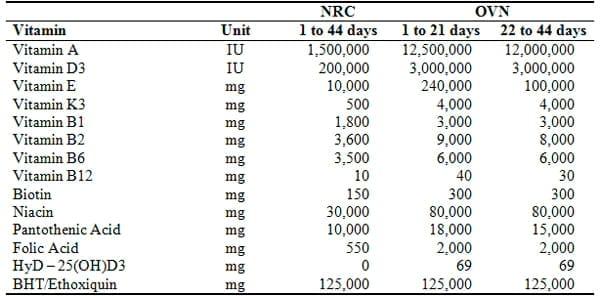Nutritional Vitamin and Meat Quality of Broilers
Effects of Nutritional Vitamin Levels on Performance and Meat Quality of Broilers
Recent studies have shown vitamin levels above minimum requirements may optimize genetic potential and improve immune status. Optimum Vitamin Nutrition (OVNTM) is a new concept in animal nutrition that aims to better production and meat quality. The objective of this study was to evaluate the effects of different vitamin levels (NRC and OVNTM) in broiler diets on productive parameters and meat quality. A total of 3,840 1-d-old Cobb-500 chicks were assigned to 2 treatments with 12 replicates (floor pens) of 160 birds each in a randomized block design. Corn-soy diets were formulated according to the standards of Granja Tres Arroyos Company. Data was analyzed by ANOVA and Duncan’s multiple range test (α error=0.10). At the end of the trial, 44 days old, a significant increase (p≤0.10) in body weight (2.733 vs. 2.784kg) and daily weight gain (62.1 vs. 63.3g) was observed with OVNTM compared to NRC. The OVNTM treatment tended (p≤0.15) to present higher European production efficiency factor (342 vs. 354) than the NRC vitamin recommendation. The OVNTM treatment also showed higher (p≤0.05) level of alpha-tocopherol (8.0 vs. 20.6µg/g) in chicken meat, better (p≤0.05) oxidative protection (TBARS, up to -28.3% at 7 days of storage) and water retention capability (+10.6%) than with NRC recommendation. No differences were observed in pH and hardness. In conclusion, optimal vitamin supplementation could be successfully used to have better broiler performance and meat quality.
KEY WORDS: Tocopherol, Lipid peroxidation, Body weight, Water retention capability.




I will emphasize that the NRC values are NOT recommendations... They are minimum requirements based on published literature values. The fact that little or no research based on actually determining a requirement for a specific vitamin (as compared to feeding different levels of multiple vitamins) limits any change in recommendations. The committee cannot just make any changes without research to back it up...
This is very good research more atuned to text book issues. Because certainly it is not easy to find producers and feed millers that will use these OVN levels just to obtain 50 g/bird over 42 day period with a feed cost of 14 g/bird. Also what about the implication on feed cost/ton? This I think may be unacceptable under today's conditions. Not that I doubt the OVN concept, it is just that super dosing one or or two of these vitamins are able to obtain similar or better results. At least the literature tells us that. At metabolic level on the other hand, we are not sure if weight gain is solely due to the extra intake of vitamins or indirectly via increased intake of other nutrients like lysine. For instance on suppose the feeds has on average digestible lysine spec of 12.5 kg/ton, 14.2 g feed will mean an extra digestible lysine intake of 180 mg. We need to think about this.
On carcass merits, this is highly desirable. I just hope we can be able to market birds fed these specs as premium poultry. Uptil now, this is still a hard sell, as poultry simply means cheap and affordable protein - especially in market where production is growing. But I would recommend this concept solely for the carcass premium traits, if consumers are convincable to see the additional health benefits. Finally I advise the concept be finetuned to birds under serious management and disease challenges. Ín súch conditions, OVN will definitely be useful.
This is a good research, and I agree with Hossan Md. Salim about the feed cost between treatments because the very much amount of vitamins added and gained little differences in BWG.
As per my knowledge, nobody is using such low levels of vitamins recommended by NRC in broiler diets. In India, there has been recommendation of 12,500 IU of Vit A, 3000 IU of vit D3 per ke finished feed for broilers since long.


United States




.jpg&w=3840&q=75)










